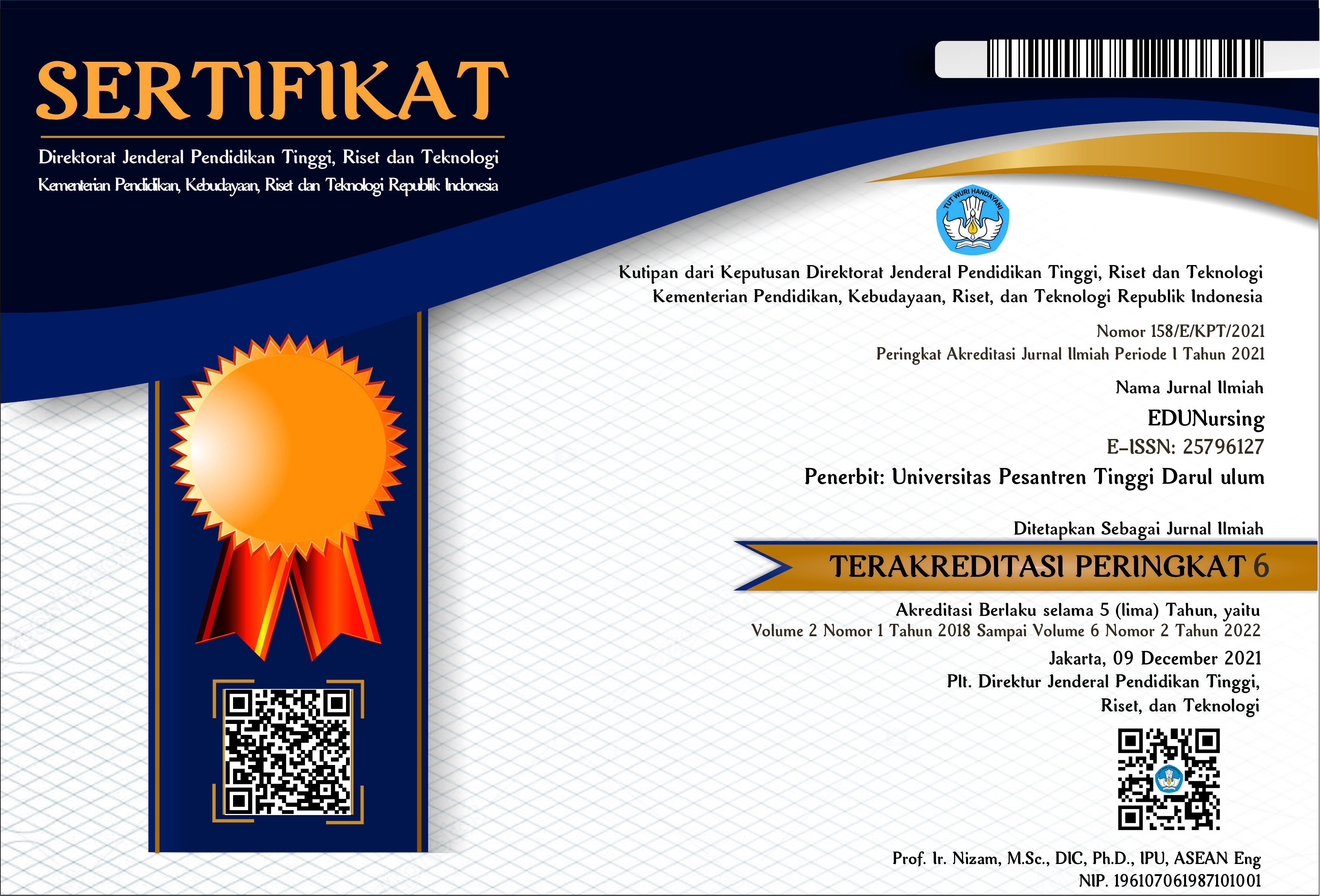PENGARUH INTEGRASI MODEL PEMBELAJARAN SIKLUS 5E DENGAN CASE BASED LEARNING (CBL) TERHADAP KECENDERUNGAN BERFIKIR KRITIS MAHASISWA
https://doi.org/10.26594/edunursing.v3i1.1833
Abstract
ABSTRACT
Critical thinking is an important competency to be developed during the nursing education process. Critical thinking is needed by nurses to make clinical decisions related to problems experienced by patients. However, several studies mention the tendency and critical thinking ability of nursing students is still low. One effort to overcome this is by applying learning methods that enable students to learn actively such as the 5E cycle learning method with CBL. The purpose of this study was to determine the effect of the integration of learning cycle 5E with CBL on students' thinking tendencies. The research design used was a Quasy experiment with a pre test post test with control group approach. The research sample was 21 students 5th semester of Nursing Unipdu Jombang as a treatment group and 19 students of Nursing study at the Health Development Program Mojokerto PPNI as a control group. Data analysis techniques used were paired t-test and Independent t-test. The results showed there were significant differences in the tendency of critical thinking both in the treatment group and the control group before and after the intervention was given with a value of p = 0.001 for the treatment group and p = 0.004 for the control group. There is a significant influence on the integration of the 5E cycle learning model with CBL on the tendency of critical thinking with a value of p = 0.043 (??0.05). Integration of the 5E cycle Learning model with CBL can increase the critical thinking tendency because it can activate the use of higher order thinking skills such as the ability to analyze, synthesize and draw conclusions. Thus the integration of the 5E and CBL cycle learning models can be used as an alternative learning method to increase students' critical thinking tendencies.
Keywords : 5E Cycle Learning Model, Case Based Learning (CBL), Critical Thinking Trends
References
DAFTAR PUSTAKA
Agbedia, C., & Ogbe, J. (2014). Critical thinking; issues in nursing education and practice. International Journal of Advanced Nursing studies, 13-17. Diakses tanggal 28 Desember 2015
Aprisunadi (2011), Hubungan Antara Berpikir Kritis Perawat Dengan Kualitas Asuhan Keperawatan Di Unit Perawatan Ortopedi Rumah Sakit Umum Pusat Fatmawati Jakarta, Tesis, Universitas Indonesia
Al Majali, Yousef Diab Salamah (2013), The Impact of (5ES) Learning Cycle on The Outcame and the Development of Creative Thinking Among Students of Seventh grade in Arabic Language course in Alqaser/Karak Brigade, International Journal of Academic Research. Vol.5. No. 5. September, 2013 diakses 21 Desember 2015
Chen, S.-L., Liang, T., Lee, M.-L. a., & I-Chen. (2011). Effects of Concept Map Teaching on Studens' Critical Thinking and Approach to Leaning and Studying. Journal of Nursing Eduvation, Vol.50, No.8.
Dahlan, M. Sopiyudin (2014), Statistik Untuk Kedokteran dan Kesehatan : Deskriptif, Bivariat, dan Multivariat, Edisi 6, Jakarta : Epidemiologi Indonesia
Dharma, K. K. (2011). Metodologi Penelitian Keperawatan. Jakarta: Trans Info Media.
Ferawati (2016). Penerapan "Case Based Learning" dalam Meningkatkan Kemampuan Berpikir Kritis Mahasiswa Keperawatan. Tesis. Universitas Muhammadiyah Yogyakarta. Yogyakarta
Fisher, A. (2001). Critical Thinking An Introduction. United Kingdom: Cambridge.
Gade, S., & Chari, S. (2013). Case-based Learning in endocrine physiology : an approach toward self-directed learning and the development of soft skills in medical students. Advances in Physiology Education, 37, 356-360.
Gunawan, I., Suraya, S. N., & Tryanasari, D. (2014). Hubungan Kemampuan Berpikir Kreatif dan Kritis dengan Prestasi Belajar Mahasiswa pada Prestasi Belajar Mahasiswa pada Matakuliah Konsep Sains II Prodi PGSD IKIP PGRI Madiun. Premiere Educandum, volume 4 Nomor i, 10-40.
Hakam, M., Sudarno, & Hoyyi, A. (2015). Analisis Jalur terhadap Faktor-Faktor yang mempengaruhi Indeks Prestasi Mahasiswa Statistika Undip. Jurnal Gaussian Volume 4, Nomor I, 61-70.
Jun, Won Hee; Lee, Eun Ju; Park, Han Jong; Chang, Ae Kyung and Kim, Mi Ja (2013), Use of the 5E learning Cycle Model Combined With Problem Based Learning for a Fundamentals of Nursing Course, Journal of Nursing Education, Volume 52, No. 12, 2013 diakses tanggal 21 Desember 2015
Kaddoura Mahmoud A. (2013). The Effect of Preceptor Behavior on the Critical Thinking Skills of New Graduate Nurses in the Intensive Care Unit, The Journal of Continuing Education in Nursing · Vol 44, No 11, 2013. Diakses tanggal 28 Desember 2015
Kulsum, U dan Hindarto, N (2011), Penerapan Model Learning Cycle pada Sub Pokok Bahasan Kalor Untuk Meningkatkan Keaktifan Dan Hasil belajar Siswa Kelas VII SMP, Jurnal Pendidikan Fisika Indonesia 7 (201 1): 128-133, ISSN: 1693-1246, diakses tanggal 28 januari 2016, HYPERLINK "http://journal.unnes.ac.id" http://journal.unnes.ac.id
LaMartina,Karen and Ward-Smith, Peggy (2014). Developing Critical Thinking Skills In Undergraduate Nursing Students: The Potential For Strategic Management Simulations. Journal of Nursing Education and Practice, 2014, Vol. 4, No. 9. HYPERLINK "http://www.sciedu.ca/jnep" www.sciedu.ca/jnep . Diakses tanggal 28 Desember 2015
Moyer, B. A.-P. (2008). Nursing Education : Foundations for Practice Excellence. USA: Davis Company.
Mutiarani, M. N. (2009). EfektifitasPpelaksanaan Diskusi tutorial PBL dengan metode Seven Jumps dalam memacu Critical Thinking Mahasiswa PSIK UMY. Yogyakarata: Skripsi FKIK Universitas Muhammadiyah Yogyakarta.
Ngalimun, S. M. (2016). Strategi dan Model Pembelajaran. yogyakarta: Aswaja Presindo.
Nkosi, Zethu; Pillay, Padmini and Nokes, Kathleen M (2013). Implementing case-based teaching strategies in a decentralised nursing management programme in South Africa. HYPERLINK "http://www.curationis.org.za" http://www.curationis.org.za . Diakses tanggal 21 Desember 2015
Notoatmodjo, S. (2007). Promosi Kesehatan dan Ilmu Perilaku. Jakarta: Rineka Cipta.
Nursalam, & Efendi, F. (2008). Pendidikan dalam Keperawatan. Jakarta: Salemba Medika.
Nursalam (2013), Metodologi Penelitian Ilmu Keperawatan, Pendekatan Praktis. Edisi 3. Jakarta : Salemba Medika
Oermann, Marilyn H (2008), Annual Review of Nursing Education, Clinical Nursing Education, Volume 6, New York, Springer Publising Company
Ormrod, j. E. (2009). Psikologi Pendidikan alih bahasa Wahyu Indianti et al. Jakarta: Penerbit Erlangga.
Piyayodilokchai, H., Panjaburee, P., Laosinchai, P., Ketpichainarong, W., & and Ruenwongsa, P. (2013). A 5E Learning Cycle Approach-Based, Multimedia-Supplemented Instructional Unit for Structured Query Language. Educational Technology & Society, 16(4), 146-159.
Potter, P. A., & Perry, A. G. (2009). Fundaamental of Nursing (7th ed.). (A. Ferderika, Penerj.) Singapore: Elsevier.
Pratama, Putri (2012) Hubungan antara kecenderungan Berpikir Kritis dengan Indeks Prestasi Kumulatif (IPK) Mahasiswa Prodi Dokter FK Undip, Karya Tulis Ilmiah, Universitas Diponegoro, Semarang, eprints.undip.ac.id/37735, diakses tanggal 3 Nopember 2018
Riyanto, Y. (2012). Paradigma Baru Pembelajaran. Jakarta: Kencana Predana Media.
Rohmah, F. A. (2006). Pengaruh Diskusi Kelompok untuk Menurunkan Stress pada Mahasiswa yang Sedang Skripsi. Humanities : Indonesian Psychological Journal, Volume 3 No.1, 50 - 62.
Rubenfeld, M. G., & Scheffer, B. K. (2006). Berpikir Kritis dalam Keperawatan. Jakarta: EGC.
Rusmegawati (2011). Pengaruh Supervisi Reflektif Interaktif Terhadap Keterampilan Berpikir Kritis Perawat Dalam Melaksanakan Asuhan Keperawatan Di Irna Rs.Dr.H.M.Ansari Saleh Banjarmasin. Tesis. Universitas Indonesia.
Sandi Danar Cynthia Sari, B. M. (2013). Penerapan Siklus Belajar 5E (Learning Cycle 5E) dengan Penilaian Portofolio untuk Meningkatkan Kualitas Proses dan Hasil Belajar pada , Materi Kelarutan dan Hasil Kali Kelarutan Siswa Kelas XI IPA 2 SMA Negeri Kartasura. Jurnal Pendidikan Kimia rogram Studi Pendidikan Kimia, , Volume 2, No.1.
Shubhada Gade, S. C. (2013). Case-Based Learning in Endocrine Physiology : an approach toward self-directed learning and development of soft skills in medical students. Advances in Physiology Education, 356-360.
Simpson, E., & Courtney, M. (2002). Critical Thinking in Nursing Education : A literatur review. International Journal on Nursing Practice.
Slavin, R. (2017). Psikologi Pendidikan, Teori dan Praktik, Edisi kesembilan Jilid I Alih Bahasa Marianto Samosir. Jakarta: Indeks Permata Puri Media.
Sugiyono. (2016). Metode Penelitian, Kuantitatif, Kualitatif dan R& D. Bandung: ALfabeta.
Suprijanto. (2012). Pendidikan Orang Dewasa. Jakarta: Bumi Aksara.
Wahl, Stacy E. and Thompson, M.(2013) Concept Mapping in a Critical Care Orientation Program: A Pilot Study to Develop Critical Thinking and Decision-Making Skills in Novice Nurses. The Journal of Continuing Education in Nursing · Vol 44, No 10, 2013. Diakses tanggal 21 Desember 2015
Wibowo, Ari; Munir dan Waslaluddin (2010) Penerapan Model Pembelajaran Siklus Belajar (Learning Cycle) 5e Dalam Meningkatkan Hasil Belajar Siswa Pada Matapelajaran Teknologi Informasi Dan Komunikasi, Skripsi, UPI, diakses tanggal 28 januari 2016,
http://cs.upi.edu/uploads/paper_skripsi_dik
Wiwit Sutiani, (2014), Penerapan Model Siklus Belajar 5e (Learning Cycle) Melalui Puzzle Gelkon (Gelas Konsep) Sebagai Media Untuk Meningkatkan Hasil Belajar Siswa Kelas Xb SMAN 6 Kota Bengkulu, Skripsi, FKIP Universitas Bengkulu, http://repository.unib.ac.id/8347/1/I,II,III,II-14-wiw.FK.pdf
Yoo, M.-S., & Park, J.-H. (2014). Effect of Case Based Learning on The Development of Graduate Nurse's Problem-Solving Ability . Nurse Education Today : www.elsevier.com/nedt, 47-51.
Downloads
Published
How to Cite
Issue
Section
License









